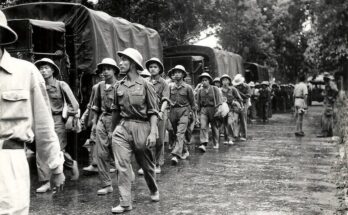
Introduction:
The sun beat down mercilessly on the white sand beaches of Anton Bakalis Island as the USS Saratoga and its fleet of warships glided silently into the lagoon. Onboard, the crew prepared for a historic moment – the first underwater detonation of an atomic bomb, code-named “Shot Baker.” Little did they know the devastation that was about to be unleashed, not just on the island, but on the very fabric of human civilization itself. As the countdown began, a hush fell over the assembled military brass and scientists. Then, with a blinding flash and a thunderous roar, the bomb exploded deep beneath the waves. A giant column of water and radioactive spray shot hundreds of feet into the air, raining down contamination over the entire atoll. The shockwaves rippled outward, sinking nearby ships and shaking the very foundations of the island.
Nuclear Testing at Bikini Atoll
Bikini Atoll was the site of the first series of nuclear tests conducted by the United States after World War II. The tests began on July 1, 1946, with “Operation Crossroads,” which included two major tests: Shot Able and Shot Baker.
- Shot Able involved an airburst explosion, while Shot Baker was detonated underwater, resulting in significant contamination of the target fleet and surrounding areas. The explosions were approximately 1,000 times more powerful than the atomic bombs dropped on Hiroshima and Nagasaki.


Broader Context of Nuclear Testing
Between 1946 and 1958, the U.S. conducted a total of 67 nuclear tests in the Marshall Islands, which included both atmospheric and underwater detonations. These tests not only affected the immediate environment but also had lasting effects on the health of the local populations and the ecological balance of the region.
Environmental and Human Impact
The consequences of these tests were dire. The indigenous people of Bikini Atoll, numbering 166, were forcibly relocated to Rogerick Atoll, and later to Kili Island, as their homeland became uninhabitable due to radioactive contamination. The initial relocation was believed to be temporary, but the islanders faced severe food shortages and hardships in their new homes. In 1954, the Castle Bravo test, the largest nuclear explosion conducted by the U.S. at Bikini, yielded 15 megatons and resulted in widespread radioactive fallout, affecting not only the atoll but also nearby inhabited islands. The fallout led to long-term health issues among the local population, including increased rates of cancer and other radiation-related illnesses.
What were the Health Consequences for the People living on Bikini Atoll after the Nuclear Tests?
The health consequences for the people living on Bikini Atoll after the nuclear tests were severe and long-lasting, stemming from the extensive exposure to radioactive fallout. The U.S. conducted numerous nuclear tests in the Marshall Islands, with Bikini Atoll being one of the primary sites from 1946 to 1958. The most notable test, Castle Bravo, released a staggering amount of radiation, affecting not only the immediate area but also distant inhabited atolls.
Immediate Health Effects
Following the tests, many Marshallese people experienced acute health issues due to direct exposure to radiation. During the Castle Bravo test, radioactive ash fell on nearby inhabited islands, including Rongelap and Ailinginae. Residents, unaware of the danger, played in the fallout, leading to immediate health problems such as:
- Radiation Burns: Many individuals suffered from beta burns and skin lesions caused by contact with radioactive materials.
- Acute Radiation Syndrome: Some individuals experienced symptoms of acute radiation sickness, including nausea and hair loss.
Long-Term Health Consequences
The long-term health effects were even more devastating, with significant increases in various diseases and conditions:
- Cancer: The incidence of cancers, particularly thyroid cancer, skyrocketed among those exposed to fallout. Studies indicated that one-third of the Rongelapese developed thyroid abnormalities, and many children developed thyroid tumors.
- Thyroid Diseases: The exposure led to a range of thyroid-related health issues, including hypothyroidism and other disorders.
- Birth Defects: The Marshallese reported a rise in birth defects, including stillbirths and congenital abnormalities, often referred to as “jellyfish babies,” which were born without bones.
- Psychosocial Impact: The trauma of displacement and the ongoing health crises contributed to significant psychological distress among the affected populations, compounding the physical health challenges.
Environmental and Nutritional Impacts
The nuclear testing also devastated the local environment, leading to food shortages and nutritional deficiencies. The relocation of the Bikini people to resource-scarce areas resulted in malnutrition and reliance on imported foods, which were often unhealthy and contributed to additional health problems like diabetes and heart disease.
Lack of Accountability and Ongoing Struggles
Despite the clear health impacts, the U.S. government has been criticized for its inadequate response to the health crises faced by the Marshallese. Many affected individuals were excluded from medical assistance programs, and the long-term effects of radiation exposure remain a contentious issue. The legacy of nuclear testing continues to affect the health and well-being of the Marshallese, as they seek recognition and justice for the harms inflicted upon them due to these tests.
Efforts Made by the U.S. Government to Decontaminate the Island
Efforts made by the U.S. government to decontaminate Bikini Atoll after the nuclear tests involved a series of initiatives aimed at assessing and mitigating the radiation levels resulting from the detonations. Here are the key actions taken:
Initial Cleanup and Assessment
- Long-Term Project Initiation: In 1969, the U.S. government began a long-term project to decontaminate Bikini Atoll. This included monitoring radiation levels and assessing the environmental impact of the nuclear tests conducted from 1946 to 1958.
- Soil and Vegetation Studies: The U.S. conducted various studies to understand the extent of contamination, particularly focusing on soil and vegetation. These studies aimed to evaluate the levels of cesium-137 and other radioactive materials present in the environment.
Decontamination Strategies
- Soil Removal: One proposed method for decontamination involved removing the top 30 centimeters of contaminated soil from Bikini Island. The contaminated soil would either be disposed of in the lagoon or used to create a land strip on the seaward side of the island. This process was estimated to take 2-4 years and cost between $36-42 million.
- Monitoring and Safety Standards: The U.S. established radiation protection standards, allowing for limited visitation to the islands. However, significant concerns remained regarding the safety of consuming local food and water, as cesium-137 levels were still deemed unsafe.
Challenges and Criticism
- Inadequate Cleanup Efforts: Critics have pointed out that the cleanup efforts have been insufficient and often merely cosmetic. Many argue that the U.S. government has prioritized scientific studies over comprehensive remediation and resettlement plans for the displaced Marshallese people.
- Continued Monitoring: Despite some cleanup efforts, radioactive materials persist in the environment. Studies have shown that radiation levels in certain areas of the Marshall Islands remain above safe limits, complicating any potential return for the displaced residents.
Current Status and Future Prospects
- Ongoing Advocacy: The Marshallese continue to advocate for further cleanup and compensation for the damages caused by nuclear testing. The U.S. has set aside approximately $110 million for environmental cleanup and resettlement, but many feel this is inadequate given the extent of the contamination and the long-term health effects on the population.
FAQs
Here are some frequently asked questions (FAQs) regarding the nuclear testing at Bikini Atoll:
What was Bikini Atoll used for during the nuclear tests?
Bikini Atoll was chosen by the United States as a nuclear testing site after World War II. Between 1946 and 1958, the U.S. conducted 23 nuclear tests at Bikini, including both atmospheric and underwater detonations, with a total yield of approximately 77 megatons of TNT.
What were the main nuclear tests conducted at Bikini Atoll?
The most notable tests included Operation Crossroads in 1946, which featured the Able and Baker tests. The Castle Bravo test in 1954 was the largest, yielding 15 megatons and resulting in significant radioactive fallout that affected nearby islands.
What happened to the inhabitants of Bikini Atoll?
The indigenous people of Bikini Atoll were evacuated in 1946 under the belief that they would be able to return after the tests. However, they were relocated multiple times due to unsuitable living conditions and continued radiation contamination. Many were moved to Kili Island, which was inadequate for sustaining their traditional lifestyle.
What health consequences did the residents face after the tests?
The residents of Bikini Atoll faced severe health consequences, including increased rates of cancer, particularly thyroid cancer, and other radiation-related illnesses. The long-term exposure to radioactive fallout has had lasting impacts on their health and well-being.
What efforts were made to decontaminate Bikini Atoll?
The U.S. government-initiated decontamination efforts that included soil removal and environmental monitoring. However, many critics argue that these efforts were insufficient and did not fully address the contamination or the needs of the displaced residents. Some proposals involved removing the top layers of contaminated soil, but significant challenges remain.
Is Bikini Atoll safe for habitation now?
As of recent assessments, radiation levels on Bikini Atoll remain above safe limits for habitation, making it unfit for permanent resettlement. The U.S. has established trust funds for the affected residents, but many still seek further compensation and support for health issues related to the nuclear tests.
What is the current status of Bikini Atoll?
Bikini Atoll is currently monitored for radiation levels, and while some marine life is thriving, the island itself remains largely uninhabited due to the lingering effects of nuclear contamination. The U.S. government continues to provide aid to the displaced Marshallese people, but the legacy of the tests continues to impact their lives.
Read Related Post
Eruption of Mount Vesuvius: Annihilation of Pompeii


